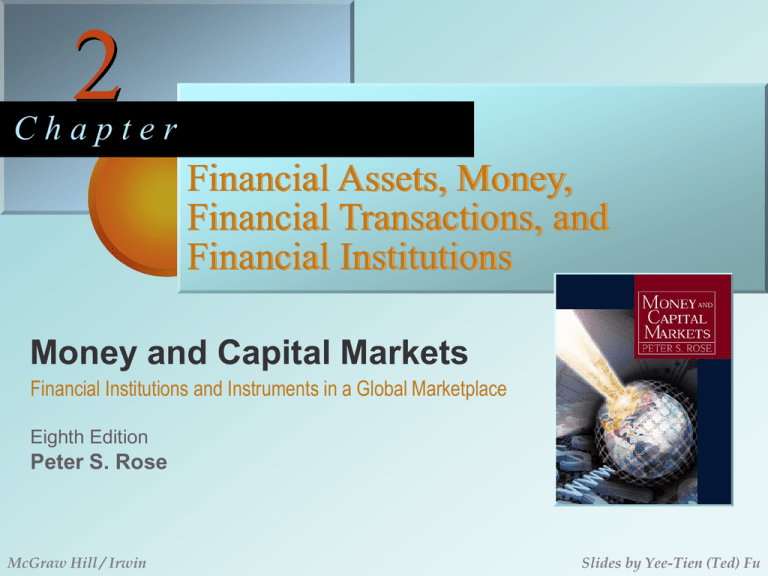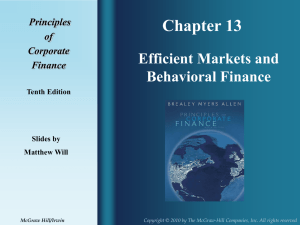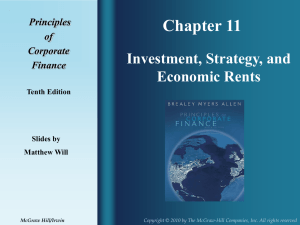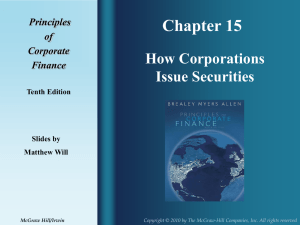
2
Chapter
Financial Assets, Money,
Financial Transactions, and
Financial Institutions
Money and Capital Markets
Financial Institutions and Instruments in a Global Marketplace
Eighth Edition
Peter S. Rose
McGraw Hill / Irwin
Slides by Yee-Tien (Ted) Fu
2-2
Learning Objectives
To learn about the channels through which
funds flow between lenders and borrowers
within the global financial system.
To discover the nature and characteristics of
financial assets – how they are created and
retired by decision-makers within the financial
system.
To explore the critical roles played by money
and the linkages between money and inflation.
McGraw Hill / Irwin
2003 by The McGraw-Hill Companies, Inc. All rights reserved.
2-3
Learning Objectives
To examine how financial intermediaries and
other financial institutions lend and borrow
funds and create and retire financial assets
within the global system of markets.
McGraw Hill / Irwin
2003 by The McGraw-Hill Companies, Inc. All rights reserved.
2-4
Introduction
The financial system is the mechanism through
which loanable funds reach borrowers.
Through the operation of the financial markets,
money is exchanged for financial claims in the
form of stocks, bonds, and other securities,
effectively transforming savings into
investment so that production, employment,
and income can grow.
McGraw Hill / Irwin
2003 by The McGraw-Hill Companies, Inc. All rights reserved.
2-5
The Creation of Financial Assets
A financial asset is …
a claim against the income or wealth of a
business firm, household, or unit of
government,
represented usually by a certificate, receipt,
computer record file, or other legal document,
and usually created by or related to the lending
of money.
McGraw Hill / Irwin
2003 by The McGraw-Hill Companies, Inc. All rights reserved.
2-6
Characteristics of Financial Assets
Financial assets are sought after because they
promise future returns to their owners and
serve as a store of value (purchasing power).
McGraw Hill / Irwin
2003 by The McGraw-Hill Companies, Inc. All rights reserved.
2-7
Characteristics of Financial Assets
They do not depreciate like physical goods,
and their physical condition or form is usually
not relevant in determining their market value.
Their cost of transportation and storage is low,
such that they have little or no value as a
commodity.
Financial assets are fungible – they can easily
be changed in form and substituted for other
assets.
McGraw Hill / Irwin
2003 by The McGraw-Hill Companies, Inc. All rights reserved.
2-8
Different Kinds of Financial Assets
Any
financial asset that is generally accepted
in payment for the purchases of goods and
services is a form of money. Examples include
currency and checking accounts.
Equities represent ownership shares in a
business firm and are claims against the firm’s
profits and proceeds from the sale of its assets.
Common stock and preferred stock are
equities.
McGraw Hill / Irwin
2003 by The McGraw-Hill Companies, Inc. All rights reserved.
2-9
Different Kinds of Financial Assets
Debt
securities entitle their holders to a
priority claim over the holders of equities to
the assets and income of an economic unit.
They are either negotiable or nonnegotiable.
Examples include bonds, notes, accounts
payable, and savings deposits.
Derivatives have a market value that is tied to
or influenced by the value or return on a
financial asset. Examples include futures
contracts, options, and swaps.
McGraw Hill / Irwin
2003 by The McGraw-Hill Companies, Inc. All rights reserved.
2 - 10
The Creation Process for Financial Assets
To acquire assets, households and business
firms may use current income and accumulated
savings – internal financing.
An economic unit may also raise funds by
issuing financial liabilities (debt) or stock
(equities), provided that a buyer can be found
– external financing.
McGraw Hill / Irwin
2003 by The McGraw-Hill Companies, Inc. All rights reserved.
2 - 11
Financial Assets and the Financial System
The act of borrowing or of issuing new stock
simultaneously gives rise to the creation of an
equal volume of financial assets.
For example, a $10,000 financial asset held by
a household that had lent money will be
exactly matched by a $10,000 liability of the
business firm that had borrowed the money.
Volume of financial assets created for lenders
= Volume of liabilities issued by borrowers
McGraw Hill / Irwin
2003 by The McGraw-Hill Companies, Inc. All rights reserved.
2 - 12
Financial Assets and the Financial System
For the balance sheet of any economic unit,
Total assets = Total liabilities + Net worth
where assets = real assets + financial assets
For the whole economy and financial system,
Total financial assets = Total liabilities
So, for the economy as a whole,
Total real assets = Total net worth
McGraw Hill / Irwin
2003 by The McGraw-Hill Companies, Inc. All rights reserved.
2 - 13
Financial Assets and the Financial System
So, society increases its wealth only by saving
and increasing the quantity of its real assets,
for these assets enable the economy to produce
more goods and services in the future.
However, the financial system provides the
essential channel necessary for the creation
and exchange of financial assets between
savers and borrowers so that real assets can be
acquired.
McGraw Hill / Irwin
2003 by The McGraw-Hill Companies, Inc. All rights reserved.
2 - 14
Lending and Borrowing in the Financial System
Economists John Gurley and Edward Shaw
(1960) pointed out that each business firm,
household, or unit of government active in the
financial system must conform to:
R – E = FA – D
where R
E
FA
D
McGraw Hill / Irwin
=
=
=
=
Current income receipts
Current expenditures
Change in holdings of financial assets
Change in debt and equity outstanding
2003 by The McGraw-Hill Companies, Inc. All rights reserved.
2 - 15
Lending and Borrowing in the Financial System
So, for any given period of time, the individual
economic unit falls into one of three groups:
Deficit-budget unit
(DBU): E > R, D > FA
i.e. net borrower of funds
Surplus-budget
unit (SBU): R > E, FA > D
i.e. net lender of funds
Balanced-budget unit
(BBU): R = E, D = FA
i.e. neither net lender nor net borrower
McGraw Hill / Irwin
2003 by The McGraw-Hill Companies, Inc. All rights reserved.
2 - 16
Lending and Borrowing in the Financial System
The U.S. Economy, 3rd Quarter of 2001 (Annualized)
Major
Sectors
of the
Economy
Households
Nonfinancial business
firms
State and local
governments
Federal government
International sector:
foreign investors
and borrowers
Net
Net
Net Lender (+)
Acquisitions Increase
or Net
of Financial
in
Borrower (-)
Assets
Liabilities of Funds
$857.8
216.0
$853.1
247.2
$ 4.7
- 31.2
29.2
68.6
- 39.4
179.5
435.4
252.2
58.6
- 72.7
376.8
Source: Board of Governors of the Federal Reserve System, Flow of Funds Accounts
2 - 17
Lending and Borrowing in the Financial System
The global financial system permits
businesses, households, and governments to
adjust their financial position from that of net
borrower (DBU) to net lender (SBU) and back
again, smoothly and efficiently.
McGraw Hill / Irwin
2003 by The McGraw-Hill Companies, Inc. All rights reserved.
2 - 18
What is Money?
All financial assets are valued in terms of
money, and flows of funds between lenders
and borrowers occur through the medium of
money.
Money itself is a true financial asset, because
all forms of money in use today are claims
against some institution, public or private.
McGraw Hill / Irwin
2003 by The McGraw-Hill Companies, Inc. All rights reserved.
2 - 19
What is Money?
M3
M2
M1
The most
liquid forms
of money,
namely
currency and
checkable
deposits.
McGraw Hill / Irwin
+
Household
holdings of
savings
deposits,
small time
deposits, and
retail money
market
mutual funds.
Institutional
money funds and
certain managed
liabilities of
depositories,
namely large
+ time
deposits,
repurchase
agreements, and
Eurodollars.
2003 by The McGraw-Hill Companies, Inc. All rights reserved.
2 - 20
U.S. Money Aggregates
Billions of Dollars
Money Supply Measures
September 2001
9,000
8,000
7,000
6,000
5,000
4,000
3,000
2,000
1,000
0
$7.8 trillion
Euros & Repos
Institutional MMFs
$5.3 trillion
Large Time Deposits
Retail Money Funds
Small Time Deposits
Savings Deposits
$1.2 trillion
Checkable Deposits
Currency
M1
M1
M2
Source: http://www.ny.frb.org/pihome/fedpoint/fed49.html
M2
M3
2 - 21
The Functions of Money
Money
serves as a standard of value (or unit of
account) for all goods and services.
Money serves as a medium of exchange, such
that buyers and sellers no longer need to have
an exact coincidence of wants in terms of
quality, quantity, time, and location.
Money serves as a store of value – a reserve of
future purchasing power – although the value
of money can experience marked fluctuations.
McGraw Hill / Irwin
2003 by The McGraw-Hill Companies, Inc. All rights reserved.
2 - 22
The Functions of Money
Money
functions as the only perfectly liquid
asset in the financial system. It exhibits price
stability, ready marketability, and reversibility.
McGraw Hill / Irwin
2003 by The McGraw-Hill Companies, Inc. All rights reserved.
2 - 23
The Value of Money and Other Financial
Assets and Inflation
Inflation refers to a rise in the average price
level of all goods and services.
Inflation lowers the value or purchasing power
of money and is a special problem in the
financial markets because it can damage the
value of financial contracts.
The opposite of inflation is deflation, where
the average level of prices for goods and
services actually declines.
McGraw Hill / Irwin
2003 by The McGraw-Hill Companies, Inc. All rights reserved.
2 - 24
The Value of Money and Other Financial
Assets and Inflation
Inflation is commonly measured using price
indices, such as:
the Consumer Price Index (CPI),
the Producer Price Index (PPI), or
the Gross Domestic Product (GDP) Deflator Index.
McGraw Hill / Irwin
2003 by The McGraw-Hill Companies, Inc. All rights reserved.
2 - 25
The Evolution of Financial Transactions
Financial systems change constantly in
response to shifting demands from the public,
the development of new technology, and
changes in laws and regulations.
Over time, the ways of carrying out financial
transactions have evolved in complexity.
In particular, the transfer of funds from savers
to borrowers can be accomplished in at least
three different ways.
McGraw Hill / Irwin
2003 by The McGraw-Hill Companies, Inc. All rights reserved.
2 - 26
The Evolution of Financial Transactions
Finance – Direct lending gives rise to
direct claims against borrowers.
Direct
Flow of funds
Borrowers
(DBUs)
(loans of spending power for an
agreed-upon period of time)
Lenders
(SBUs)
Primary Securities
(stocks, bonds, notes, etc.,
evidencing direct claims against
borrowers)
Simple Difficult to match & risky
McGraw Hill / Irwin
2003 by The McGraw-Hill Companies, Inc. All rights reserved.
2 - 27
The Evolution of Financial Transactions
Semidirect Finance –
Direct lending with the
aid of market makers who assist in the sale of
direct claims against borrowers.
Primary Securities
Primary Securities
(direct claims
against
borrowers)
(direct claims
against
borrowers)
Borrowers
(DBUs)
Proceeds of
security sales
Security
brokers,
dealers, &
investment
bankers Flow of funds
(less fees and commissions)
Lenders
(SBUs)
(loans of
spending power)
Lower search (information) costs
Risky & matching is still required
McGraw Hill / Irwin
2003 by The McGraw-Hill Companies, Inc. All rights reserved.
2 - 28
The Evolution of Financial Transactions
Indirect
Finance – Financial intermediation of
funds.
Primary Securities
(direct claims against
ultimate borrowers in the
form of loan contracts,
stocks, bonds, notes, etc.)
Ultimate
borrowers
(DBUs)
Secondary Securities
(indirect claims against ultimate
borrowers issued by financial
intermediaries in the form of
deposits, insurance policies,
retirement savings accounts, etc.)
Financial intermediaries
(banks, savings and loan associations,
insurance companies, credit unions,
mutual funds, finance companies,
pension funds)
Ultimate
lenders
(SBUs)
Flow of funds
Flow of funds
(loans of spending power)
(loans of spending power)
Low risk & affordable
McGraw Hill / Irwin
2003 by The McGraw-Hill Companies, Inc. All rights reserved.
2 - 29
Relative Size and Importance of
Major Financial Institutions
Total Financial Assets Held by U.S. Financial Institutions
($ billions at year-end)
1960
Financial intermediaries:
Commercial banks
$224
S&L assoc. and savings banks
111
Life insurance companies
116
Private pension funds
38
Investment co. (mutual funds)
17
State & local gov’t pension funds
20
Finance companies
28
Property-casualty insurance co.
26
Money market funds
––
Credit unions
6
Mortgage companies
––
Real estate investment trusts
––
Other financial institutions:
Security brokers and dealers
7
1970
1980
1990
2000
$489
252
201
110
47
60
63
50
––
18
––
4
$1,248
794
464
413
64
198
199
174
74
72
16
6
$3,340
1,358
1,357
1,629
602
820
611
534
498
202
49
13
$6,488
1,219
3,204
4,587
4,457
2,290
1,138
872
1,812
441
36
62
16
36
262
1,221
Source: Board of Governors of the Federal Reserve System, Flow of Funds Accounts
2 - 30
Classification of Financial Institutions
Depository institutions derive the bulk of their
loanable funds from deposit accounts sold to
the public.
Commercial banks, savings and loan associations,
savings banks, credit unions.
Contractual institutions attract funds by
offering legal contracts to protect the saver
against risk.
Insurance companies, pension funds.
McGraw Hill / Irwin
2003 by The McGraw-Hill Companies, Inc. All rights reserved.
2 - 31
Classification of Financial Institutions
Investment institutions sell shares to the public
and invest the proceeds in stocks, bonds, and
other assets.
Investment companies, money market funds, real
estate investment trusts.
McGraw Hill / Irwin
2003 by The McGraw-Hill Companies, Inc. All rights reserved.
2 - 32
Portfolio (Financial-Asset) Decisions by
Financial Institutions
A number of factors affect the making of
portfolio decisions – deciding what financial
assets to buy or sell.
The relative rate of return and risk attached to
different financial assets.
The cost, volatility, and maturity of incoming
funds provided by surplus-budget units.
Hedging principle – the approximate matching of
the maturity of financial assets held with liabilities
taken on.
McGraw Hill / Irwin
2003 by The McGraw-Hill Companies, Inc. All rights reserved.
2 - 33
Portfolio (Financial-Asset) Decisions by
Financial Institutions
The
size of the individual financial institution.
Larger financial institutions tend to have greater
diversification in their sources and uses of funds
and economies of scale.
Regulations
McGraw Hill / Irwin
and competition.
2003 by The McGraw-Hill Companies, Inc. All rights reserved.
2 - 34
Disintermediation of Funds
Disintermediation refers to the withdrawal of
funds from a financial intermediary by the
ultimate lenders (savers) and the lending of
those funds directly to the ultimate borrowers.
Disintermediation involves the shifting of
funds from indirect finance to direct and
semidirect finance.
McGraw Hill / Irwin
2003 by The McGraw-Hill Companies, Inc. All rights reserved.
2 - 35
Disintermediation of Funds
Financial Disintermediation
Primary Securities
Ultimate
borrowers
(DBUs)
Financial
intermediaries
Ultimate
lenders
(SBUs)
Loanable funds
McGraw Hill / Irwin
2003 by The McGraw-Hill Companies, Inc. All rights reserved.
2 - 36
Disintermediation of Funds
Some new forms of disintermediation have
appeared over the past two decades.
Initiation by financial intermediaries: Some
banks sell off their loans because of difficulties
in raising capital.
Initiation by borrowing customers: Some
borrowing customers learned how to raise
funds directly from the open market.
McGraw Hill / Irwin
2003 by The McGraw-Hill Companies, Inc. All rights reserved.
2 - 37
Bank-Dominated Versus Security-Dominated
Financial Systems
Lesser-developed financial systems are often
bank-dominated financial systems, in which
banks and other similar institutions dominate
in supplying credit and attracting savings.
The more mature systems today are becoming
security-dominated financial systems, in which
traditional intermediaries play lesser roles and
growing numbers of borrowers sell securities
to the public to raise the funds they need.
McGraw Hill / Irwin
2003 by The McGraw-Hill Companies, Inc. All rights reserved.
2 - 38
Money and Capital Markets in Cyberspace
One popular money management site is Money
Magazine’s http://money.cnn.com/, which helps
individuals track the assets they already hold
or wish to hold.
To determine how much things are worth after
the effects of inflation and to work our way
back into the past to see how the purchasing
power of our money has changed over time,
visit http://www.westegg.com/inflation/.
McGraw Hill / Irwin
2003 by The McGraw-Hill Companies, Inc. All rights reserved.
2 - 39
Chapter Review
Introduction
The Creation of Financial Assets
Characteristics of Financial Assets
Different Kinds of Financial Assets
The Creation Process for Financial Assets
Financial Assets and the Financial System
Lending and Borrowing in the Financial
System
McGraw Hill / Irwin
2003 by The McGraw-Hill Companies, Inc. All rights reserved.
2 - 40
Chapter Review
Money as a Financial Asset
What is Money?
The Functions of Money
The Value of Money and Other Financial
Assets and Inflation
The Evolution of Financial Transactions
Direct Finance
Semidirect Finance
Indirect Finance
McGraw Hill / Irwin
2003 by The McGraw-Hill Companies, Inc. All rights reserved.
2 - 41
Chapter Review
Relative Size and Importance of Major
Financial Institutions
Classification of Financial Institutions
Portfolio (Financial-Asset) Decisions by
Financial Intermediaries and Other Financial
Institutions
Disintermediation of Funds
New Types of Disintermediation
McGraw Hill / Irwin
2003 by The McGraw-Hill Companies, Inc. All rights reserved.
2 - 42
Chapter Review
Bank-Dominated Versus Security-Dominated
Financial Systems
McGraw Hill / Irwin
2003 by The McGraw-Hill Companies, Inc. All rights reserved.









